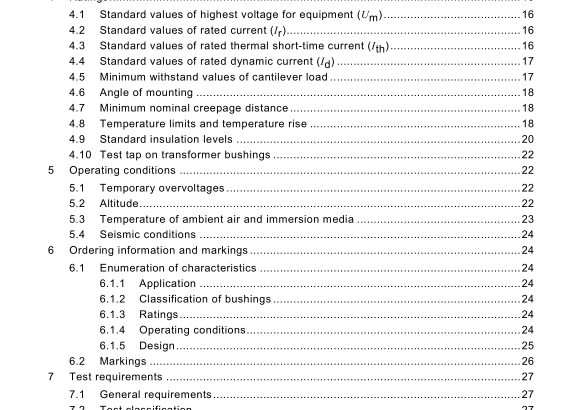IEC 60137:2008 pdf download – Insulated bushings for alternating voltages above 1 000 V
1 scope
This International Standard specifies the characteristics and tests for insulated bushings.
This standard is applicable to bushings, as defined in Clause 3, intended for use in electricalapparatus,machinery,transformers,switchgear and installations for three-phase alternatingcurrent systems, having highest voltage for equipment above 1 000 v and power frequenciesof 15 Hz up to and including 60 Hz.
Subject to special agreement between purchaser and supplier, this standard may be applied,in part or as a whole, to the following:
bushings used in other than three-phase systems;bushings for high-voltage direct current systems;bushings for testing transformers;
bushings for capacitors.
Special requirements and tests for transformer bushings in this standard apply also to reactorbushings.
This standard is applicable to bushings made and sold separately.Bushings which are a partof an apparatus and which cannot be tested according to this standard should be tested withthe apparatus of which they form part.
2Normative references
The following referenced documents are indispensable for the application of this document.For dated references, only the edition cited applies.For undated references, the latest editionof the referenced document (including any amendments) applies.
IEC 60038:1983,lEC standard voltages
Amendment 2 (1997)
IEC 60050(212):1990,International Electrotechnical Vocabulary – Part 212: Insulating solids,liquids and gases
IEC 60059,IEC standard current ratings
IEC 60060-1,High-voltage test techniques – Part 1 : General definitions and test requirements
lEC 60068-2-17:1994,Basic environmental testing procedures – Part 2: Tests – Test Q:Sealing
IEC 60071-1,Insulation co-ordination – Part 1 : Definitions,principles and rulesIEC 60076-5, Power transformers – Part 5: Ability to withstand short circuit
IEC 60076-7: Power transformers – Part 7: Loading guide for oil-immersed transformers
IEC 60216-2,Electrical insulating materials – Thermal endurance properties – Part 2:;Determination of thermal endurance properties of electrical insulating materials – Choice oftest criteria
IEC 60270,High-voltage test techniques – Partial discharge measurements
lEC 60376,Specification of technical grade sulfur hexafluoride (SF6) for use in electricalequipment
IEC 60480,Guidelines for the checking and treatment of sulphur hexafluoride (SF6) takenfrom electrical equipment and specification for its re-use
IEC 60505,Evaluation and qualification of electrical insulation systems
lEC 60815, Guide for the selection of insulators in respect of polluted conditions
IEC 61462,Composite insulators – Hollow insulators for use in outdoor and indoor electricalequipment – Definitions, test methods,acceptance criteria and design recommendations
IEC 61463,Bushings – Seismic qualification
IEC 62155,Hollow pressurised and unpressurised ceramic and glass insulators for use inelectrical equipment with rated voltages greater than 1 000 v
IEC 62217,Polymeric insulators for indoor and outdoor use with nominal voltage greater than1 00o v – General definitions, test methods and acceptance criteria
lEC 62271 (all parts), High-voltage switchgear and controlgear
IEC 62271-1,High-voltage switchgear and controlgear – Part 1: Common specifications
IEC Guide 109,Environmental aspects – Inclusion in electrotechnical product standards
IEC Guide 111,Electrical high-voltage equipment in high-voltage substations – Commonrecommendations for product standards
CISPR 16-1 (all parts),Specification for radio disturbance and immunity measuring apparatusand methods
CISPR 18-2,Radio interference characteristics of overhead power lines and high-voltageequipment – Parts 2: Methods of measurement and procedure for determining limits
3 Terms and definitions
For the purposes of this document, the following terms and definitions apply.
3.1
bushing
device that enables one or several conductors to pass through a partition such as a wall or atank,and insulates the conductors from it; the means of attachment(flange or fixing device)to the partition forms part of the bushing
3.2
liquid-filled bushing
bushing in which the space between the inside surface of the insulating envelope and thesolid major insulation is filled with oil
3.3
compound-filled bushing
bushing in which the space between the inside surface of the insulating envelope and thesolid major insulation is filled with an insulating compound
3.4
liquid-insulated bushing
bushing in which the major insulation consists of oil or another insulating liquid
3.5
gas-filled bushing
bushing in which the space between the inside surface of the insulating envelope and thesolid major insulation is filled with gas (other than ambient air) at atmospheric pressure orhigher
NOTE This definition includes bushings which are intended to form an integral part of gas-insulated equipment.the gas of the equipment being in communication with that of the bushing.
3.6
gas-insulated bushing
bushing in which the major insulation consists of gas (other than ambient air) at atmosphericpressure or higher
NOTE 1 This definition includes bushings which are intended to form an integral part of gas-insulated equipment,the gas of the equipment being in communication with that of the bushing.
NOTE 2 A bushing which contains solid insulating materials other than the envelope containing the gas (e.g.support for conducting layers or insulating cylinder), is a combined insulation bushing (see 3.13).
NOTE 3 A bushing in which the desired voltage grading is obtained by an arrangement of conducting or semi-conducting layers incorporated in an insulating material (e.g. plastic filim) is referred to as a gas insulatedcondenser graded bushing.
3.7
gas-impregnated bushing
bushing in which the major insulation consists of a core wound from paper or plastic film (GIF)and subsequently treated and impregnated with gas (other than ambient air) at atmosphericpressure or higher, the space between the core and the insulating envelope being filled withthe same gas
